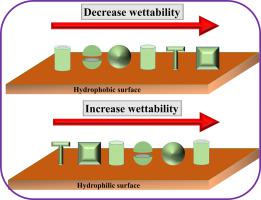Progress in Organic Coatings ( IF 6.6 ) Pub Date : 2022-08-02 , DOI: 10.1016/j.porgcoat.2022.107062 Sushanta K. Sethi , Rupam Gogoi , Akarsh Verma , Gaurav Manik

|
Governing the physical and chemical characteristics of contact area among solid substrate and liquid droplets is a widely used strategy to fabricate superhydrophobic and superhydrophilic surfaces.
While both surface morphology and surface free energy of a solid substrate conclude its wettability, designing the surface with right topology has reserved immense focus by researchers in last few decades. In the pursuit to achieve such goals of immaculate surfaces, some intriguing question need to be answered, for instance, what will happen if one takes same material for the solid substrate but having different morphological features? Irrespective of chemical nature, how the physical appearance of a rough surface controls the wettability? To unravel these questions, we examine the wettability of different surrogate models using coarse-grain (CG) simulations. Interesting results were obtained for apparent contact angles on varying the morphology of a particular surface with different geometrical shapes. Different surface geometries such as square, nail, solid sphere, hollow sphere, rod, and hollow sphere of hydrophobic (poly(dimethylsiloxane)) (PDMS) and hydrophilic (poly (vinyl alcohol)) (PVA) polymers were created. In hydrophobic case, the square followed by nail shape corrugated surface demonstrated least wettability by restricting the penetration of water beads inside the grooves. Whereas, for hydrophilic case, the shell shaped surface showed excellent wetting condition due to maximum availability of unoccupied volume. It was concluded from the present study that hollow cylinder and square shaped corrugated surface could be respectively used to obtain the maximum and the least surface wettability possible. This investigation, through the evolved understanding of the role of surface geometry at the nano level could guide researchers and materials scientists to develop effective materials with desired wetting conditions.
中文翻译:

粗糙表面的几何形状如何影响其润湿性?- 粗粒度模拟分析
控制固体基质和液滴之间接触区域的物理和化学特性是制造超疏水和超亲水表面的一种广泛使用的策略。
虽然固体基材的表面形态和表面自由能都确定了它的润湿性,但设计具有正确拓扑结构的表面在过去几十年中一直受到研究人员的极大关注。在追求完美无瑕表面的过程中,需要回答一些有趣的问题,例如,如果固体基材采用相同的材料但具有不同的形态特征会发生什么?无论化学性质如何,粗糙表面的物理外观如何控制润湿性?为了解开这些问题,我们使用粗粒 (CG) 模拟检查了不同替代模型的润湿性。在改变具有不同几何形状的特定表面的形态时,获得了表观接触角的有趣结果。不同的表面几何形状,例如正方形,制造了疏水(聚(二甲基硅氧烷))(PDMS)和亲水(聚(乙烯醇))(PVA)聚合物的钉、实心球、空心球、棒和空心球。在疏水情况下,方形和指甲形波纹表面通过限制水珠在凹槽内的渗透表现出最低的润湿性。而对于亲水性情况,由于未占用体积的最大可用性,壳形表面显示出优异的润湿条件。从本研究得出的结论是,可以分别使用空心圆柱体和方形波纹表面来获得最大和最小的表面润湿性。本次调查,


























 京公网安备 11010802027423号
京公网安备 11010802027423号